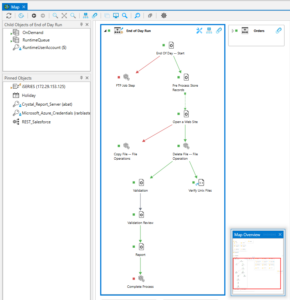Low-Code IT Automation: The Path to Unified Orchestration
More is demanded of IT than ever before. Low-code IT automation enables teams to achieve simplified, unified orchestration for operational peace of mind.

IT departments have a lot on their plate and demands are only increasing. Complex scripts use process automation to tie together disparate systems and apps – helping to bring together siloed tools and promote digital transformation. Security and auditing are program-specific, some scripts have no oversight, and each system is prone to its own set of errors and vulnerabilities. Which apps caused an issue, when, and on what machine??
Low-code IT automation enables teams to achieve simplified, unified orchestration and operational peace of mind. Let’s explore a case where low-code automation moves IT towards unified orchestration.
The Case: If You Like Your Scripts, You Can Keep Your Scripts
The Problem
Your company has a long history of scripting. Over the years, scripts have evolved from language-to-language, new scripts were added, old scripts were refined, and ongoing maintenance remains an important practice. Today, a combination of legacy VB scripts and more current PowerShell scripts are leveraged for the majority of your department’s batch processing and daily tasks. Your team is looking for ways to promote digital transformation and reduce its reliance on scripting as it transitions to a cloud-based Amazon EC2 environment, but it doesn’t have the capacity to reinvent the wheel for its existing workflows.
Many scripts are scheduled using Windows Task Scheduler, which is usually reliable, but doesn’t offer much granularity or flexibility when tying multiple scripts together to achieve an end-to-end process, and passing secure data from script-to-script is difficult to accomplish and maintain.
Some new IT and business processes have been built out using a low-code automation tool, but the licensing model charges per job which makes tying together many individual and disparate pieces costly and ineffective. Security and auditing are crucial to legal compliance for your industry, but various technologies, scripting languages, and platforms make it difficult to keep everything secure and reportable. Your CIO is stressing the need to cut wasteful costs, centralize control, and move faster, but your team can only do so much.
The Solution
There are numerous benefits of low-code automation. Users can easily address the needs of a code-heavy shop and remove the stress of migrating to newer, more agile process automation. The right solution also promotes proper end-to-end workflow design by not charging extra for additional jobs or workflow components like connecting lots of disparate scripts or adding in calls to additional applications. It uses drag-and-drop functionality, an intuitive user interface and built-in templates, variables and job steps to make it easier to launch automation projects in less time. Script language-independent scheduling and execution means any technology that your OS can support, the low-code automation tool can support. Then, built-in script lifecycle management functionality means you can copy-and-paste your script contents to vault and audit all future uses and modifications. You can migrate dozens of scripts in a matter of hours, not weeks or months.

Jobs can be easily and flexibly configured or scheduled to run in parallel, sequentially, after specific constraints are met, or when events occur like a process finishing with a specific exit code or containing a specific string. Plus, future reliance on scripting can be drastically reduced by using the drag-and-drop interfaces; even newer or lower-skilled employees can effectively assemble end-to-end workflows. Finalized workflows can be executed locally, in the cloud, or hybrid combination using the same secure and reliable engine. The result is better and more cost-effective design practices, more control and insight into the script-based aspects of your operations, and the unified orchestration of no-code, low-code, and code-based technologies into seamless end-to-end workflows.
Ultimately, making these investments in a low-code platform supports the overall goal of digital transformation. From application development to more niche process automation, low-code automation gives everyone from the most advanced developers to business users the ability to use automation to better meet their business needs.
Pictured above: Real-time, visual depiction of a workflow within ActiveBatch IT Automation’s Map View workflow monitor and designer. Multiple Jobs — some script-based and some assembled using low-code drag-and-drop workflow blocks — are arranged to form an end-to-end workflow. Source: ActiveBatch IT Automation
See three more cases in our free White Paper:
Frequently Asked Questions
Low-code automation is methodology used by ActiveBatch that uses pre-built connectors, templates, variables and job steps to streamline and simplify the development process. Removing the need for complex coding, workflows can be created and launched quickly, without the risk of human error.
Low-code IT automation enables teams to achieve simplified, unified orchestration and operational peace of mind while making automation more accessible to junior members of the IT team as well as business users.
Low-code automation makes automation more accessible, reliable and efficient for today’s busy IT teams and business users. It replaces the time-consuming and error-prone coding that was required by legacy schedulers. Now developers can put low-code automation into the hands of more junior IT resources, allowing them to create and launch automation. This expands the reach of automation and helps the organization need and exceed its goals without the need for additional IT resources.
Low-code automation facilitates the development of workflows that require some limited coding with the built-in templates, variables, job steps and more. This allows IT and business processes to more quickly and accurately be created.
No-code automation doesn’t require any coding or programming skills, making automation more accessible to non-IT users.
ActiveBatch is an example of a low-code workflow automation platform. It incorporates a variety of built-in tools to make workflows easy to create and launch. Pre-built connectors and a REST API adapter make it easy to connect with enterprise applications. Inside the platform, users can create workflows with reusable variables, job steps and templates. This also makes it easy to update IT and business processes when changes are required.
Low-code test automation is an approach that automates the software testing process, dramatically reducing the work required by an IT resource. This speeds up the testing process and removes the risk of human error in the testing process. It also makes automation more accessible, allowing other, less skilled testers to be involved in the overall process.








